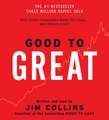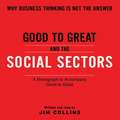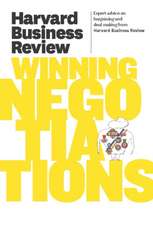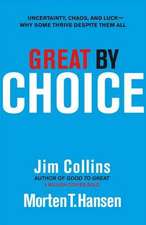Good to Great: Why Some Companies Make the Leap...And Others Don't: Good to Great, cartea 1
Autor Jim Collinsen Limba Engleză Hardback – 15 oct 2001
Built to Last, the defining management study of the nineties, showed how great companies triumph over time and how long-term sustained performance can be engineered into the DNA of an enterprise from the very beginning.
But what about the company that is not born with great DNA? How can good companies, mediocre companies, even bad companies achieve enduring greatness?
The Study
For years, this question preyed on the mind of Jim Collins. Are there companies that defy gravity and convert long-term mediocrity or worse into long-term superiority? And if so, what are the universal distinguishing characteristics that cause a company to go from good to great?
The Standards
Using tough benchmarks, Collins and his research team identified a set of elite companies that made the leap to great results and sustained those results for at least fifteen years. How great? After the leap, the good-to-great companies generated cumulative stock returns that beat the general stock market by an average of seven times in fifteen years, better than twice the results delivered by a composite index of the world's greatest companies, including Coca-Cola, Intel, General Electric, and Merck.
The Comparisons
The research team contrasted the good-to-great companies with a carefully selected set of comparison companies that failed to make the leap from good to great. What was different? Why did one set of companies become truly great performers while the other set remained only good?
Over five years, the team analyzed the histories of all twenty-eight companies in the study. After sifting through mountains of data and thousands of pages of interviews, Collins and his crew discovered the key determinants of greatness -- why some companies make the leap and others don't.
The Findings
The findings of the Good to Great study will surprise many readers and shed light on virtually every area of management strategy and practice. The findings include:
- Level 5 Leaders: The research team was shocked to discover the type of leadership required to achieve greatness.
- The Hedgehog Concept (Simplicity within the Three Circles): To go from good to great requires transcending the curse of competence.
- A Culture of Discipline: When you combine a culture of discipline with an ethic of entrepreneurship, you get the magical alchemy of great results. Technology Accelerators: Good-to-great companies think differently about the role of technology.
- The Flywheel and the Doom Loop: Those who launch radical change programs and wrenching restructurings will almost certainly fail to make the leap.
Perhaps, but who can afford to ignore these findings?
| Toate formatele și edițiile | Preț | Express |
|---|---|---|
| Hardback (2) | 122.92 lei 24-30 zile | +69.14 lei 4-10 zile |
| Random House – 2004 | 122.92 lei 24-30 zile | +69.14 lei 4-10 zile |
| HarperCollins Publishers – 15 oct 2001 | 201.29 lei 3-5 săpt. | +31.47 lei 4-10 zile |
Din seria Good to Great
- 27%
 Preț: 122.92 lei
Preț: 122.92 lei -
 Preț: 191.26 lei
Preț: 191.26 lei -
 Preț: 89.88 lei
Preț: 89.88 lei -
 Preț: 136.01 lei
Preț: 136.01 lei -
 Preț: 190.82 lei
Preț: 190.82 lei -
 Preț: 85.96 lei
Preț: 85.96 lei -
 Preț: 37.00 lei
Preț: 37.00 lei -
 Preț: 52.00 lei
Preț: 52.00 lei -
 Preț: 136.82 lei
Preț: 136.82 lei -
 Preț: 137.47 lei
Preț: 137.47 lei -
 Preț: 78.47 lei
Preț: 78.47 lei -
 Preț: 197.12 lei
Preț: 197.12 lei -
 Preț: 97.91 lei
Preț: 97.91 lei
Preț: 201.29 lei
Nou
Puncte Express: 302
Preț estimativ în valută:
38.53€ • 39.70$ • 32.53£
38.53€ • 39.70$ • 32.53£
Carte disponibilă
Livrare economică 10-24 februarie
Livrare express 24-30 ianuarie pentru 41.46 lei
Preluare comenzi: 021 569.72.76
Specificații
ISBN-13: 9780066620992
ISBN-10: 0066620996
Pagini: 320
Dimensiuni: 156 x 235 x 27 mm
Greutate: 0.47 kg
Editura: HarperCollins Publishers
Colecția HarperBusiness
Seria Good to Great
ISBN-10: 0066620996
Pagini: 320
Dimensiuni: 156 x 235 x 27 mm
Greutate: 0.47 kg
Editura: HarperCollins Publishers
Colecția HarperBusiness
Seria Good to Great
Recenzii
One of the top ten business books of 2001 — Business Week
Notă biografică
Descriere
Can a good company become a great one and, if so, how?
After a five-year research project, Collins concludes that good to great can and does happen. In this book, he uncovers the underlying variables that enable any type of organization to make the leap from good to great while other organizations remain only good. Rigorously supported by evidence, his findings are surprising - at times even shocking - to th emodern mind.
Good to Great achieves a rare distinction: a management book full of vital ideas that reads as well as a fast-paced novel.
























